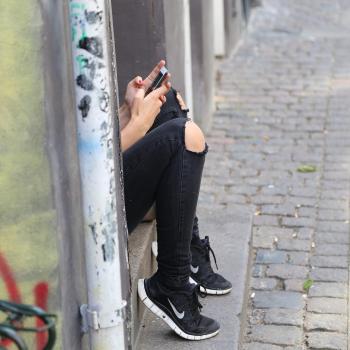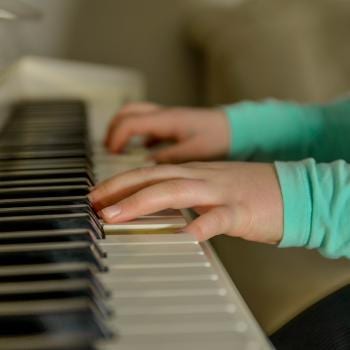I find myself a bit conflicted here. I’m seeing a story about a South Carolina mother charged with neglect pass across facebook. “Mom Jailed Because She Let Her 9-Year-Old Daughter Play in the Park Unsupervised,” the title reads. My friends are outraged, and are recounting stories of playing alone at the park themselves at that age. But when I clicked on the link I quickly felt that the title—and my friends’ defenses—were a bit misleading. This was not a case of a girl walking to a park several blocks from home to play with her friends for a few hours.
It seems that Debra Harrell, who works at MacDonalds, was unable to find childcare for her daughter over the summer. At first her daughter came with her mother to work and spent her time on the family’s laptop. But then the laptop was stolen and the daughter asked to be dropped off at a popular park 1.5 miles away while her mother worked. And that is just what they did until a concerned parent asked the girl where her mother was, and called social services when the girl responded with “at work.”
Summer childcare is a huge problem for people in or near poverty. Strike that, childcare at all is a huge problem for people in or near poverty. Until children are old enough for kindergarten, someone has to watch them, and once kids are in school someone has to watch them before or after school or in the summer. These things aren’t free. Some states do offer subsidized childcare in various forms, but I once watched a friend spend months on a waiting list for one of those programs. What we have right now is not enough.
My daughter Sally is currently in daycare, which runs year-round. It’s expensive, and we are fortunate to be able to afford it. Next month Sally starts kindergarten, and next summer we will need to find summer childcare. Our current plan is to alternate between time at home, when that works with our schedule, and attending local camps put on by the YMCA or parks department. These camps tend to run $100 to $150 per week. This isn’t something everyone can afford.
As I read about Harrell’s case, I was reminded of another story. Several months ago I watched facebook friends defend the actions of an Arizona mother, Shanesha Taylor, who left her two small children (ages two and six months) in a hot car, alone, for an hour. Why did they defend her actions? Because she said she’d done it because she didn’t have childcare and had to go to a job interview. News articles reported that she and her two children were currently homeless. My facebook friends and others used this case as a poster child for better childcare options, and all I could think was that if someone hadn’t found those kids and called the cops (as someone did) there was a very good chance they might not be here today.
I am all for working towards better childcare options. I am all for educating people on how few options poor people often have, and how trapped it makes them. Absolutely. I would also totally be on board with arguing that the woman’s circumstances must be considered when deciding on whether to press charges or what services to offer—and I’ll get back to this more in a moment. What concerned me was that I actually saw people defending her decision to leave her children in that car. The reality is that Taylor put her children’s lives at risk. Her children could have died. Watching people defend Taylor’s decision to put their child’s life at risk—rather than simply drawing attention to the difficult situation Taylor found herself in without access to childcare and the bad choices her situation drove her to make—made me very uncomfortable.
Both Harrell and Taylor are women of color. I am confident that this plays a role in how their actions are perceived by the general public and in what sentences they receive. The real tragedy here, to my mind, is that these women are criminalized when what they really need are services. I know that social services often tries to offer services, and maybe they would do so in these cases after each woman’s trial (which seems a bit late). Taylor’s decision to leave her children in a hot car—which (I hope) everyone in this day and age knows is dangerous—does need to be addressed, but Harrell left her daughter in a far less dangerous situation (more on this later) that likely does not merit legal prosecution at all. What does criminalizing these women do to their future job prospects and attempts to better their lives and those of their children? In cases where child neglect occurs because there seems to be no other option, I feel like the first response should be to offer services.
Let me bring all of this back to the girl and the park. I strongly dislike seeing my own side (or any side) engaging in false advertising or misleading people. Those discussing this case should provide all the facts—that Harrell is being prosecuted for leaving her daughter alone at a park while going to work—rather than saying (as I’m seeing done) that Harrell has been jailed because she let her daughter go to the park by herself. Over and over again I’m seeing people say “I went to the park on my own at that age,” but again and again they’re talking about walking a few blocks to the park while their parents are at home, not being left at a park while their parents go to work every day. These are not the same thing, and discussing it in these terms feels misleading to me.
Of course, I am not jumping on board with those talking about how very dangerous the park is for a child either. I wrote about this just yesterday—“stranger danger” is vastly overestimated. That child was likely safer while at the park than while being driven there by her mother (car accidents are much more common than kidnappings). This is where I see a strong difference between Harrell’s case and Taylor’s case—Harrell left her 9-year-old daughter alone at a park to play, which was arguably not very dangerous, but Taylor left her 2-year-old and 6-month-old children alone in a hot car, which was very dangerous.
To be honest, I’m not sure where I stand. I know I stand on the side of more childcare options. I know I stand on the side of providing services rather than criminalizing women in tight situations. Growing up, I was told that 12 was the magic age for being left at home alone. I did some googling and that does appear to be the current recommendation. I’m unsure whether that goes for things like playing at the park or down the street, although I would imagine that if the parent is at home it ought to be fine for a child of 9 (or even younger) to be down the block or at a local park with neighborhood friends. I grew up in a cornfield. We didn’t have neighbors or parks we could walk to, so this wasn’t an issue. Today, I don’t let Sally play outside of our apartment alone, but if the 10-year-old neighbor girl (who seems quite responsible) is out there and wants to play then I let her go (with some ground rules, of course).
I used to be a big fan of the blog Free Range Kids. The basic idea was that children need more freedom than they currently have, and need to be trusted more—that children are more responsible than we give them credit for. All of these things I can get on board with. But I stopped following Free Range Kids probably a year ago because I got fed up by their opposition to the UN Convention on the Rights of the Child and their continued promotion of pictures of children from the 1880s and 1890s as some sort of heyday of childhood, which is so ahistorical I don’t even know where to start. Yes, things are different today than they used to be. But different does not necessarily mean worse. Sometimes different means better. And frankly, I have utterly no desire to return to 1888 with its child mortality and child labor rates.
The more I learn and the longer I live the more I’m convinced that change tends to be a mixture of good and bad, and that we can’t turn back the clock and should instead do our best to accommodate and adjust to change rather than fighting it. Oh, I’m not talking about Nazis, I’m talking about economic change, and social change, that sort of thing. “When I was a child, we used to” is not necessarily a valid response in this sort of situation. Twenty years ago, forty years ago, sixty years ago, many things were different. We cannot recreate that past. instead, we need to look around at what we have in the present and do the best we can with it.
The truth is that children in the U.S. are safer today than they have ever been. The truth is also that parents in the U.S. today are more anxious about their children’s safety than they have ever been. This paradox is at the center of Peter Stearns’ excellent 2004 work, Anxious Parents. I would also recommend Paula Fass and Michael Grossberg’s excellent 2011 work, Reinventing Childhood after WWII. What I appreciate about this work is that the authors resist the declension narrative and explain that childhood has changed since WWII—or even been “reinvented,” to use their words—as a result of very real changes in our physical, economic, and social world. Again, this is why the “back in my day” argument simply does not work.
Perhaps part of the solution is more education—a better understanding of the actual dangers children face, a better understanding of the law, etc. Perhaps part of the solution is being more willing to help our friends and neighbors out—if Harrell’s daughter had had a friend she could have been left with, or if Harrell had had a relative she could leave her daughter with, she wouldn’t have faced such a tight childcare pinch. Perhaps part of the solution is becoming more accepting of children of a certain age spending time in public spaces with their friends or on their own.
What do you think? What would you add to this conversation?














